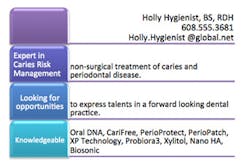Dental hygiene careers: The last 12 weeks
HOW DO YOU PREPARE FOR A LIFE-CHANGING EVENT, SUCH AS DOC'S RETIREEMENT?
By SHIRLEY GUTKOWSKI, RDH, BSDH
Imagine — you come into the office you’ve worked at for over 10 years, having finally found hygiene heaven. You have a great job, working the hours you want with a dentist who gets dental hygiene — or at least gets out of the way and lets you work your magic. This morning’s schedule was filled with fake patients and you find out that there’s a team meeting. Surprise!
The minutes unfold. Your autonomic nervous system kicks in. Heart racing, mouth drying, hands getting clammy, you hear the words you were not expecting: “Ladies, I’m retiring. The practice hasn’t sold and I’m forced to close the doors. Our last day of work will be in 12 weeks.” The team meeting ends as assignments are passed out to the practice manager and the receptionist about what to say to patients as they come in or check out. The assisting team is educated on how to make sure patients’ dental work is scheduled before the last day. The dentist announces to whom patients will be referred. Your assignment is to not freak out.
RELATED: Gutkowski: The New World
RELATED: Gutkowski: Hygiene diagnosis
The upshot is you have 12 weeks of work before you’re finished. You are suddenly a job hunter. Where do you start? What do you do? You’ve felt good about your position; the patients loved you and don’t want anyone else to work on their teeth. You want to maintain the relationships you’ve built. Is that something measureable? Can you put that in a resume? How can you bring that up in an interview?
I’ll say this right now: Every hygienist on the planet has patients who love them and will follow them to the ends of the earth. The most important thing that you can show on your resume and during an interview is what makes you different from everyone else. That’s where the focus is. If you don’t already know your production per person/day/week/month, start finding out. New graduates, the biggest competition to an experienced oral health care provider, don’t have any numbers that reflect how much of a team player they can be in the practice. Here’s the secret for the new grads: Clinicians who have been practicing for 20 years don’t have those numbers either!
Here’s another secret: All the patients who follow you will need expensive dental treatment. It’s a known fact that new patients are offered more treatment than existing. The amalgam that your current dentist doesn’t feel like changing out, especially now, is going to be a high priority for whomever the new dentist is. This turn of events will put you in a position of defending the past practice and the new one you chose to be part of. Hiring dentists know that patients you bring to the office could be a problem. So dwelling on the patients you’ll bring to the practice may not be such a good thing.
The best measuring stick a potential employer has to work with is one with production statistics on it. Start looking at your numbers. Gather them, work with them, and cross your fingers that they show what you think they do. What do you think a hygienist can produce in a day? According to HygieneFusion consulting expert Liz Nies, a dental hygienist should produce about $1,600-1,800 per day. That total may or may not include the exam fee. When reporting your daily production in your cover letter or on your resume itself, simply mention whether the amount reflects the exam or not.
Here’s an example of a resume entry showing production per day:
Dr. Doughnut (General Family Practice) Saliva, WI: 5 years
Eaglesoft proficient
Laser certification
Produced $1,400 per day on average (no exam, no X-ray)
40% perio per 4-day week
Other numbers to gather in the next 12 weeks are:
Production
- Perio
- Sealants
- Diagnostic tests
- Whitening
- Radiographs
- Casts
- Fluoride application
Percentage of perio patients
Percentage of product sales as opposed to treatment
- Fluoride alternatives
- Toothbrushes
- Probiotics or xylitol products
Hours of CE per year in the last few years
- Any famous ones?
- Any CE that made you change the way you practice?
Hours you’re down per month
- What your primary activity is during downtime (do not list assisting the assistants, front office personnel, or anything else everyone does)
Even if your employer is not retiring, why wait? Start today, find out what you produce and keep track from this day forward — and that’s not all.
As you’re reassessing your future, you’ll find new questions and new hurdles to deal with. For instance: the level of competition. Great dollar figures are one thing, but it’s likely that there are a few candidates who will have better or similar numbers. Ask yourself what else you do that makes you an outstanding employee to your boss. Then prove it.
If you don’t have a portfolio, it’s not too late to start one. Angie Stone of HyLife, LLC and a CareerFusion member says having a portfolio is how you really show what you can do. Heidi Emmerling, RDH, PhD, and author of The Purple Guide: Paper Persona is a proponent of dental hygiene portfolios. “There are two main types of portfolios: a master, where you keep everything forever, and the presentation portfolio that you take with you to an interview,” she explains.
Stone has been working on her portfolio since she was in high school. Angie’s master portfolio consists of three binders. Everything she’s ever created and a sampling of the many pictures she’s taken over the years showing her at work are in those binders. When the product educator job at Xlear became available, she was ready to apply with a focused resume and a portfolio that showed her teaching others about xylitol with Xlear products in the photographs. She didn’t have to stage the pictures; she just had to find them in the master portfolio. Once found, she moved the pictures and other supporting information into her presentation portfolio. She had a portfolio ready for her first nonclinical job in no time.
Dr. Emmerling states in Paper Persona Workbook:
“In contrast to the resume or CV, the portfolio is a gorgeous walk-in closet with your inventory of artifacts organized and displayed in a manner where you can see everything. It has multiple purposes:
- Shows off your best work at the interview
- Helps you take stock of your professional growth
- Serves as a research tool to contribute information to the profession.”
Building and using a portfolio
Let’s look at how to build and use a portfolio. Say you decide to institute an oral probiotic into the practice. Over the duration of your time using Evora probiotics, you keep track of the number of patients you have on the tablets and then collect data showing the shift in oral health.
Perhaps you photograph the amount of oral biofilm on the teeth using the new three-tone disclosing paste from GC America. After a certain amount of time you take another picture of the same person with the disclosing solution, evaluating how much less biofilm had accumulated after taking the probiotics regularly. Let’s pretend your modus operandi for all the new products you’ve implemented since you started practicing as a dental hygienist is to keep meticulous records of the product’s performance over the first three months of use. That raw data is kept in your master portfolio.
Many dental hygienists make up information sheets for their patients to help them understand a process or procedure. In this example, the info sheet you create for the patient could include a picture of the Evora lozenges and a small three-month calendar where people could mark the days they took the supplement. That information sheet is handed to each patient as they receive their bottle of the lozenges, and a copy is also going to live in your master portfolio.
You’ve kept photographs and records in the computer on each patient, tracking the number of teeth with biofilm, and how much of the teeth were covered before your patient started on the Evora. Then perhaps you’ve created a questionnaire for after the treatment that asked qualitative questions such as how they liked taking the lozenge, or how they managed to remember to take it once a day, and when during the day they found the most success in remembering. Then you’d create a summary and make some discoveries about how people use oral probiotics. Conceivably you’d even write a paper or at least a paragraph summarizing the results. In the master portfolio you’d keep the photographs, the photo release form from the patient, the info sheet you’ve created to help explain the oral probiotic, and an evaluation sheet that you created to keep track of the results. You may even report on the success of the new product at a team meeting. That you reported at a team meeting is also included in your master portfolio.
When it comes time to find a job or, for some, to keep a job, you’ll pull out the summary of your Evora cases and any other new products or procedures you’ve implemented over the time you’ve been a dental hygienist. If the practice you’re applying to is a cosmetic practice, you’ll pinpoint the whitening aspect of the Evora; if it’s a perio office, you’ll highlight the decrease in biofilm; and if it’s a geriatric practice, you’ll focus on the changes in tongue coating you’ve found in the patients using it. Flexibility in your presentation portfolio is the key here.
The financial tidbits to show production increases per week should be included, even if you have only 10 weeks of data to gather. Another good financial morsel to include is the number of perio cases treated per week, the number of re-treats, or the number of teeth you saved by helping bring down the A1c numbers in your patients with diabetes. At the very least, you’ll be showing your prospective employer that you’re busy doing dental hygiene during downtime.
Including production summaries or the one about Evora, or the reduction in instrument costs you tracked by switching over to the American Eagle XP instruments should be in the presentation portfolio. Or you can include proof of a difference you can see from using an air polishing procedure before placing sealants. The potential for inclusions is endless.
So how does a presentation portfolio look? According to Paper Persona, it can be a three-ring binder, folder, website, or jump drive. The first page is a copy of your resume, the same one you sent to the office. The presentation portfolio may also contain any or all of the following:
- A typical schedule
- Relevant articles that helped you develop your dental hygiene practice
- Relevant CE course listing
- Nice notes from patients
- Awards, honors (like the Sunstar Award of Distinction, or even something non-dental related)
- Employment settings in which you have worked
- Examples of materials you’ve prepared for patients
- Research or projects you were involved in
- Before-and-after photos of select cases
- Production numbers
The classic “show, don’t tell” from your writing teacher should be echoing in your head about now.
Once you’ve gathered the information to showcase, put it into a binder to leave behind. Find something inexpensive but classy. Office supply stores carry some pretty cool presentation folders.
Carla Gantz had a good experience using her dental hygiene portfolio. The dentist she worked for was retiring and closing down the practice. Carla knew she provided a high level of dental hygiene while employed there. She practiced at a Pankey and LVI level. Using a portfolio, she was able to show prospective employers she didn’t just go there for a free vacation. She was the only candidate to have a portfolio. “The doctors just kept shaking their heads with this amazed look on their faces as they paged through it. If it wasn’t for Angie [Stone] teaching us about portfolios at CareerFusion, I wouldn’t have knocked their socks off,” she said.
One last thing you may want to work on during your last 12 weeks is a networking card. A networking card is very similar to a business card but it’s not meant to get business, per se. According to The Purple Guide: Paper Persona, there are four parts to a networking card: name, contact information, objective, and highlights of your talents or focus. If you’re a talented singer, it would only go on your networking card if you’re looking for work as a singer.
As your portfolio develops, you’ll see how much more fun dental hygiene can be. Interviews will be a snap because you’ve been preparing for them for a long time. You can just smile to yourself when the interviewer looks puzzled as you hand over your presentation portfolio at the interview. Confidence is a desirable employee trait. RDH
SHIRLEY GUTKOWSKI, RDH, BSDH, FACE, is a clinical dental hygienist. Her experience and free thinking have made her a popular international speaker and award-winning author. She is the author of many books, chapters, and articles to support dental hygienists, and she is a career coach at CareerFusion. Her books can be purchased through www.rdhpurpleguide.com. Information on CareerFusion is at www.Careerfusion.net.
Three things to never put on a resume or cover letter
OSHA COMPLIANT
CPR CERTIFIED
X-RAY CERTIFICATION
EXAMPLE OF EVORA SUMMARY
We started dispensing oral probiotics at the office in November 2010 and continue on to the present, although this level of data was collected during the first three months only. We used a text messaging service to help people remember to take their lozenges. During the three months of this summary, the total of sales realized was $14,400. (New pricing as of June2012: $12,000.) Our adult patients liked the idea that we didn’t harp on brushing and flossing by offering them a supplement to help decrease oral biofilm.
Total number of patients in three months: 240
Number of people who used the entire 180
three-month supply:
% of people who notice better breath: 100
% of people who notice color improvement: 97
% of people who thought brushing was easier: 75
% of people who notice improvement in their gums: 87
Most favorable comments
- Breath tastes cleaner
- Teeth feel cleaner
- Brushing is easier
- Spouse comments on improvement
- Teeth seem whiter
Most unfavorable comments
- Hard to remember
- Not much of a taste
Past RDH Issues


